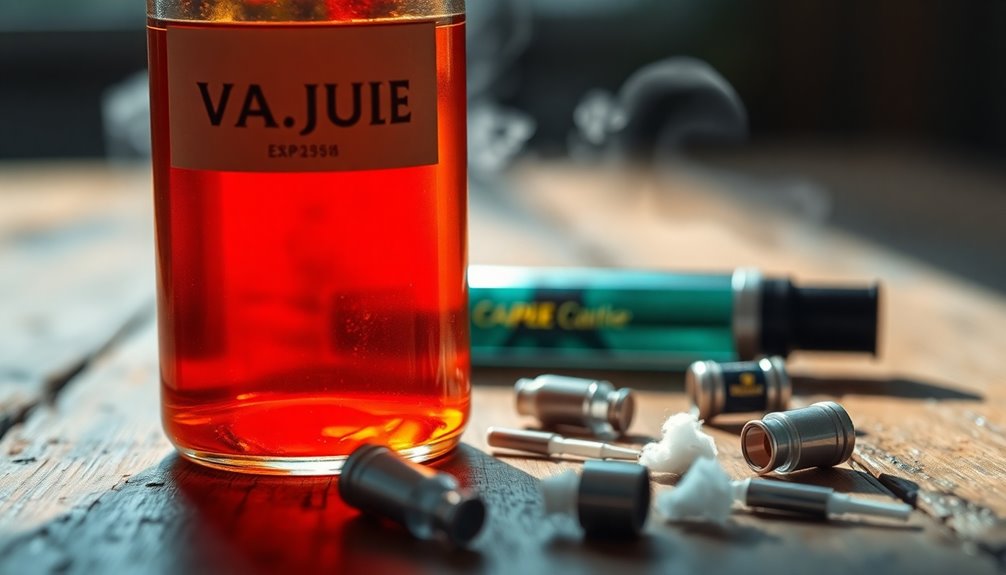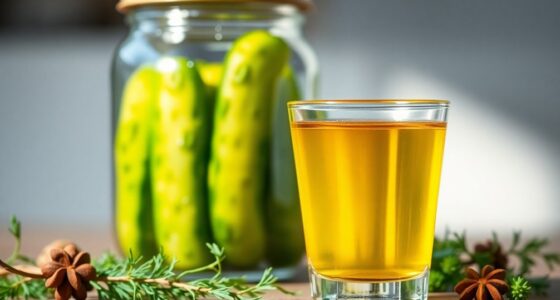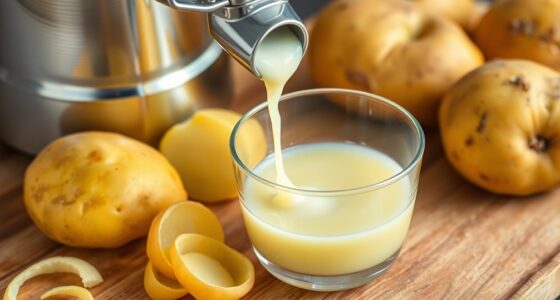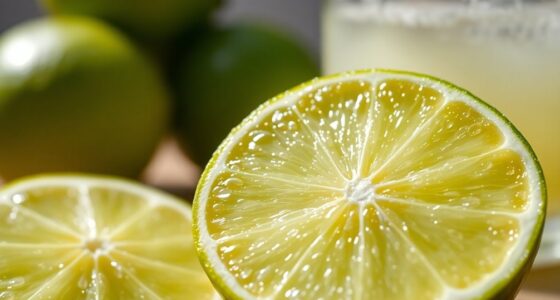Vape juice is good for varying lengths of time depending on its type and whether it's opened. Unopened, nicotine-free vape juice can last 1-2 years, while nicotine-infused juice is best used within a year. Once opened, nicotine-free liquids last 6-12 months, while freebase nicotine lasts 3-6 months. To maximize its lifespan, store it properly. If you want to know more about shelf life and storage tips, there's plenty more to explore!
Key Takeaways
- Unopened nicotine-free vape juice lasts 1-2 years, while nicotine-containing juice is good for up to 1 year.
- Opened nicotine-free e-liquids remain fresh for 6-12 months, whereas freebase nicotine lasts 3-6 months.
- Proper storage in cool, dark environments can significantly extend the shelf life of vape juice.
- Signs of expired vape juice include discoloration, altered taste, unpleasant smell, and changes in texture.
- Always check expiration dates on labels to avoid disappointment with stale vape juice.
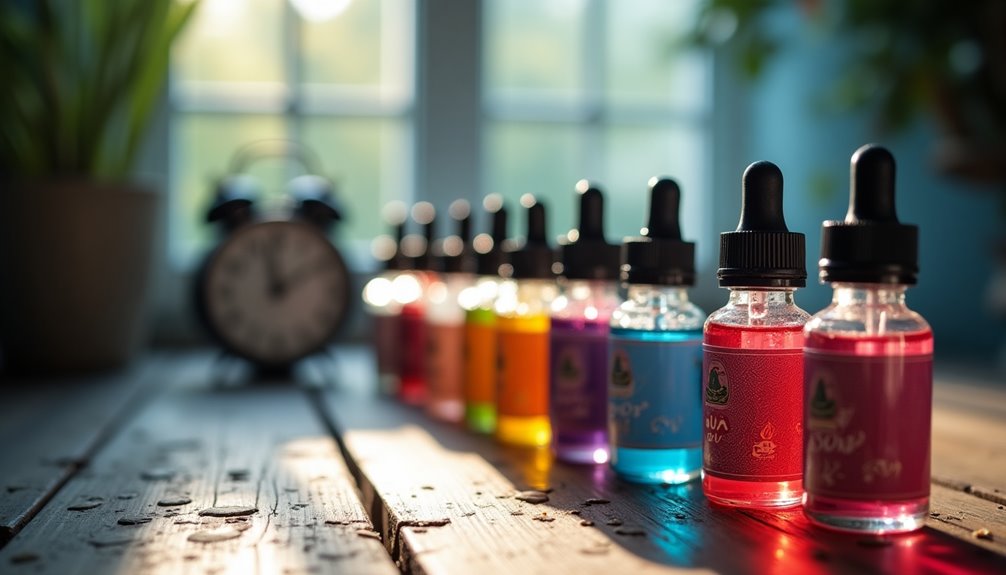
When you're stocking up on vape juice, it's important to know how long it stays good. Understanding the shelf life of vape juice can save you from the disappointment of grabbing a bottle only to find it expired. Generally, unopened vape juice can last anywhere from 1-2 years if it's nicotine-free, while those with nicotine typically have a shelf life of up to 1 year. This means that when you're buying your supplies, checking the expiration dates on the labels can be your first line of defense against expired vape juice.
Once you've opened your vape juice, the game changes a bit. Nicotine-free e-liquids usually last about 6-12 months after being opened. However, if you're using freebase nicotine e-liquids, they typically last only about 3-6 months once the seal is broken. Nicotine salts have a similar story; they can stay good for 6-12 months when sealed, but the longevity can decrease once you start using them. So, it's smart to keep track of when you first opened a bottle to avoid any unpleasant surprises.
The longevity of your vape juice doesn't just depend on the nicotine content; it also hinges on the quality of the ingredients in e-liquid and how you store your e-liquid. Exposure to air, heat, and light can all contribute to the degradation of your vape juice.
For instance, if you leave your e-liquid sitting in a hot car or in direct sunlight, you can expect it to expire much sooner than it would in a cool, dark place. Proper storage is key to maximizing shelf life, so always aim to keep your vape juice in a cool, dark environment.
Regularly checking for signs of expired e-liquid can also keep your vaping experience fresh. Look for discoloration, which can indicate that the juice has degraded. An altered taste is another major red flag; if what you're vaping tastes off or different than when you first opened it, it's best to err on the side of caution and toss it out.
You want to enjoy your vape without worrying about the quality of the juice, so being proactive can save you from an unpleasant experience.
Frequently Asked Questions
Can You Use 3 Year Old Vape Juice?
You can use 3-year-old vape juice, but it's probably not a great idea.
After this time, you might notice changes like a darker color, separation, or an off-smell.
While it's unlikely to pose serious health risks, the flavor and nicotine effectiveness could be pretty disappointing.
Always inspect the juice first—if it looks or smells off, it's best to toss it and get a fresh bottle for a better vaping experience.
Does Vape Juice Actually Expire?
Yes, vape juice does expire. Unopened nicotine-free e-liquids can last 1-2 years, while those with nicotine typically last around a year.
You'll notice signs of expiration like darkening color, separation, or a harsh taste. Even if it doesn't seem harmful, using expired vape juice isn't recommended.
To extend its shelf life, store it in a cool, dark place, and keep it tightly sealed. That way, you can enjoy it longer!
Is It Bad if My Vape Juice Turns Brown?
If your vape juice turns brown, it's a sign of oxidation, especially if it contains nicotine.
While this doesn't always mean it's unsafe, the flavor and quality might be affected.
If you notice separation or an unusual smell alongside the discoloration, it's best to toss it out.
To prevent this from happening, store your vape juice in a cool, dark place.
Taking these steps helps maintain its freshness and quality longer.
Can Vape Juice Be Bad?
Yes, vape juice can go bad. You can tell by looking for signs like darkening color, separation, or a strange smell.
If you notice a muted taste or cloudiness, it's likely expired. Heat, light, and air accelerate degradation, so store it properly.
While vaping expired juice isn't usually harmful, it can ruin your experience. Always check for these indicators to ensure you're enjoying your vape at its best!
Conclusion
As you take that last puff, you can’t help but wonder—how long has that bottle of vape juice really been sitting there? The clock ticks softly, and the flavors dance on your palate, but is it still fresh? With every inhale, the answer lingers, teasing your curiosity. It could be weeks or even months, but wouldn’t you rather experience the vibrant burst of a new bottle? Don’t let uncertainty cloud your enjoyment—check your stash and savor the moment! As you indulge in your vape, your mind wanders to other peculiar substances and their effects. It’s fascinating how something as simple as how pickle juice affects digestion can spark such curiosity about what we consume. Just as you wouldn’t want stale vape juice, you should be mindful of what you’re putting into your body, ensuring every experience is as fresh and invigorating as it can be.
Cindy thoroughly researches juicing trends, techniques, and recipes to provide readers with practical advice and inspiration. Her writing style is accessible, engaging, and designed to make complex concepts easy to understand. Cindy’s dedication to promoting the advantages of juicing shines through her work, empowering readers to make positive changes in their lives through the simple act of juicing.

